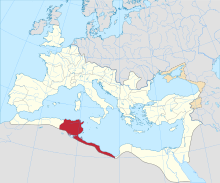
The Diocese of Gisipa (Latin: Rite Gisipensis) is a home suppressed and titular see of the Roman Catholic Church, suffragan of the Archdiocese of Carthage. [1] [2]

The Diocese of Gisipa (Latin: Rite Gisipensis) is a home suppressed and titular see of the Roman Catholic Church, suffragan of the Archdiocese of Carthage. [1] [2]
The bishopric of Gisipa, was centered on a Roman town called Gisipam, the location of which is now lost to history, [3] although being in Africa Proconsularis it is certain that it was in what is modern north Tunisia.
The sources mention four bishops.
Today Gisipa survives as titular bishop, [4] the current bishop is Vitorino José Pereira Soares, Auxiliary Bishop of Porto. [5] [6]
Aïn El Kebira is a city located 27 km north far from Sétif. As Ancient Satafis it was a bishopric, which remains a Catholic titular see.

Turrisblanda, was a Roman and Byzantine era colonia (town) in the Roman Empire province of Byzacena in what is today modern Tunisia. Its exact location remains unknown. It was also a capital of an historic diocese of the Roman Empire. The bishopric remains today as a titular see of the Roman Catholic Church. The current bishop is Jan Szkodoń, Auxiliary Bishop of Cracow.

Unizibira was an ancient town and bishopric in Roman North Africa which remains a Latin Catholic titular see.
Villamagna in Proconsulari was a town in the Roman province of Africa Proconsulare. It is identified with the modern village of Henchir Mettich, located around 50 km from Carthage in Tunisia.
Taborenta, Mauretania Caesariensis was a Berber civitas (town) and bishopric in Roman North Africa. It disappeared during the 7th century, and is assumed to be near Saida in modern Algeria. It was nominally restored in 1933 as a titular see.

Buslacena was a Roman town and the seat of an ancient Christian bishopric in the Roman province of Africa Proconsularis.
Henchir-El-Meden is a locality and archaeological site in Tunisia.
Sebkha-El-Coursia is a salt pan, locality and archaeological site in Tunisia. It was an ancient Roman Catholic diocese.
Henchir-Khachoum is a locality and series of archaeological sites in Sidi Bouzid Governorate modern Tunisia. The ruins are strewn along a tributary of the Oued El Hatech river east of Sbeitla. During the Roman Empire there was a Roman town of the Roman province of Africa Proconsularis, called Muzuca, one of two North African towns to bare that name.

Mattiana was a Roman-Berber civitas in the province of Africa Proconsularis. The locale existed during late antiquity, and was situated in northern Tunisia.

Uzzipari was a Roman town of the Roman Empire during late antiquity. An exact location for the town has been lost to history although that it was in the Roman province of Africa Proconsolaris means it must have been in northern Tunisia.

Zarna was a Roman town of the Roman Empire during late antiquity. An exact location for the town has been lost to history, although that it was in the Roman province of Africa Proconsolare means it must have been in northern Tunisia.

Culusi was a Roman town of the Roman province of Africa Proconsolare, located near Carthage. It is also known as Culcitana or Culsitana. The city is tentatively identified with ruins in the suburbs of Tunisia.

The Diocese of Aquensis in Byzacena is a home suppressed and titular see of the Roman Catholic Church.

The Diocese of Carcabia is a titular see of the Roman Catholic Church.

The Diocese of Dices, is a titular see of the Roman Catholic Church. The location of the seat of the diocese is unknown for certain, but is perhaps identifiable with Henchir-Sidi-Salah, Tunisia. Henchir Sidi Salah was an ancient diocese in the Roman-Berber province of Byzacena.
Cabarsussi was an ancient civitas (municipality) and bishopric in the Roman province of Byzacena, that is tentatively identifiable with ruins at Drâa-Bellouan in modern Tunisia. The current bishop is Terence Robert Curtin, auxiliary bishop of Melbourne.

Precausa was an ancient civitas of the Roman province of Byzacena in North Africa. Its exact location remains unknown but it was in the present Sahel region of Tunisia.
Satafi, was a Roman town in the Roman province of Mauretania Caesariensis, North Africa. It lasted through the Vandal Kingdom and Roman Empire, until at least the Muslim conquest of the Maghreb, in late antiquity. An exact location of the town is not known but, it was probably in Algeria.
The diocese of Presidio is a suppressed and titular see of the Catholic Church.